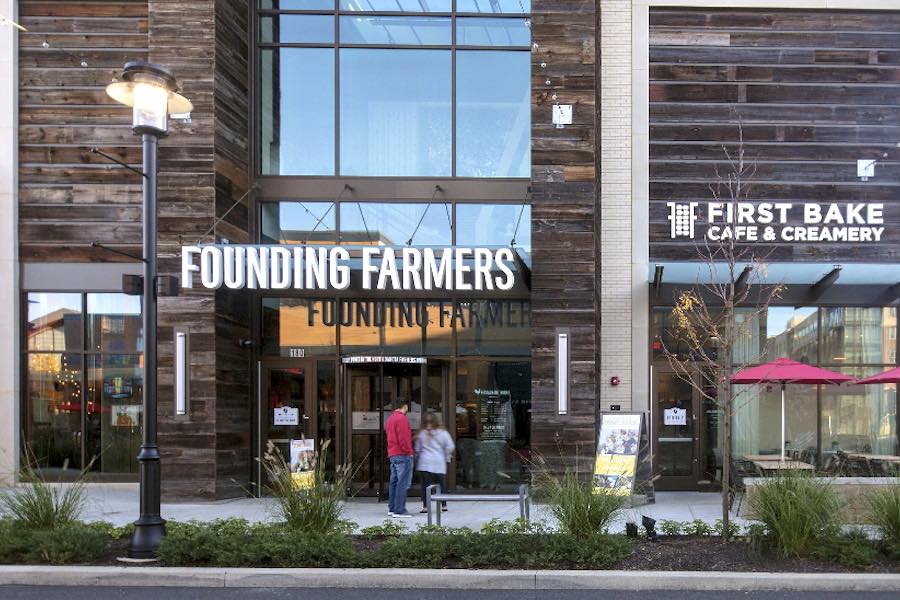Prepare to Pay a “Wellness Fee” at this King of Prussia Restaurant
It's about employee health. But it's not all about employee health.

King of Prussia’s Founding Farmers restaurant, which is charging customers a 5-percent wellness fee. (Image courtesy King of Prussia Town Center)
We’ve all gotten used to spending more at restaurants. The cost of goods has risen, drastically in some cases. Some restaurants have instituted auto-gratuity policies, no matter the size of your party. Then there are those “credit card convenience fees” many restaurants now add to your check. The only way out of those is to pay with cash. (I had to chuckle when one Delco restaurant listed that confusingly as a “technology fee.”) But here’s an added charge I encountered just the other day: a wellness fee.
Founding Farmers is a chain of restaurants based in the Washington D.C. area. A King of Prussia location that debuted in 2017 is the sole Founding Farmers outside of the Beltway. Founding Farmers promotes its reputation for being a more progressive type of restaurant. They point to their early adoption of gender-inclusive bathrooms as evidence of that. (Though Founding Farmers is popular in the D.C. area, not everybody is impressed. The Washington Post food critic gave them zero stars.)
And in addition to the $11 you’ll fork over for oatmeal and the $13.50 for onion rings at the King of Prussia Founding Farmers, you’re also now being charged a five percent “wellness fee.” This is part of a growing trend in restaurants across the country, and Founding Farmers recently instituted their new wellness fee policy.
We asked Founding Farmers to chat with us about their wellness fee, but we never heard back from the corporate office. An employee at the King of Prussia Founding Farmers pointed out to us that the restaurant will remove the wellness fee upon request. But what is this wellness fee all about?
A statement on the company website explains that the surcharge “supports free mental health resources” for their employees and their families, “access to health insurance, paid sick leave, and increased operating costs.”
“It is not a gratuity,” the statement continues. “Our goal is to be transparent while maintaining the value and standards our guests have come to know and love.”
In a more lengthy blog post, the owners of Founding Farmers went into a bit more detail about what exactly this wellness fee covers. And here are those items, verbatim:
Paid sick leave for employees who are not feeling well.
Mental health support services, including no-cost access to online therapy and unlimited text therapy through TalkSpace, for our employees and their immediate family members.
Ongoing on-site flu clinics in all seven of our restaurants.
Access to affordable health insurance through increased company contributions toward premiums.
Increasing labor costs and new wage-related legislation.
Increased cost of goods due to supply chain issues for our napkins, silverware, plates, aprons, kitchen uniforms, equipment repair, and more. Almost everything we use now costs more than before the pandemic.
Off-setting the loss and debt accrued as a result of the pandemic.
In other words, it’s definitely not all about employee health. It’s also about the health of the business.
In a recent social media thread, one Philly chef wondered why Founding Farmers wouldn’t just meld this extra five percent into the menu, across the board. The company addresses that point as well in their post:
We want to maintain value for our guests while restructuring and evolving our business model in this new day. As menu item prices cross certain thresholds (i.e., 19 to 21 or 29 to 30), guest buying behavior is affected, meaning that people may not select their first choice, but instead select an item priced well below – this trade, which can be from $31 down to $24 or $25, results in lower total sales, even though menu prices are higher.
These decisions also affect ordering an appetizer, a second beverage, or dessert at the end of the meal. This means that in order to net the same revenue for the business through a price increase, we’d need to raise prices substantially (in the 15% to 20% range) more than 5% – costing diners more – which is why we see the 5% charge as win/win, as opposed to the even larger menu price increase which is lose/lose.
How do you feel about paying a so-called “wellness fee” in a restaurant? Hit us up here. We’d love to know.


